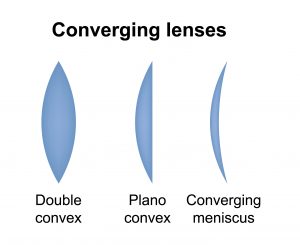A convex lens is used in cameras, telescopes, microscopes, and other essential gadgets, but you might not know what it is or how it works. This article will explain what a convex lens is, how it works, the different types, and what fields it is applied in.
A convex (converging) lens is a lens that combines light beams that are parallel to the lens’s principal axis. They are easily recognized by their distinctive shape, which is thick in the center and tapered at the top and bottom. Instead of being rounded inward, the edges are rounded outward. When light passes through a lens, it is refracted at a particular spot based on the incidence angle.
Depending on their distance from the surface, light beams will be bent at varying angles due to the curvature of the surface. This is in contrast to what happens when using a concave (divergent lens) in which light is scattered in a direction perpendicular to the axis.

A convex lens is classified as a converging lens because it allows all light rays to converge on a single point along the lens’s primary axis. It is the opposite of a concave (diverging) lens that separates light rays into several points.
Plano-convex lenses have one flat surface and one spherical surface. These simple lenses function best with infinite parallel light, should be used in non-critical settings, and are typically used in robots, focusing optics, and other fields.
A double convex (bi-convex) lens has both sides bent outward. This is the opposite of a bi-concave lens with two sides bent inward. Compared to a plano-convex lens of the same diameter and surface radius, a bi-convex lens has a shorter focal length. However, today’s optical tools require longer focal lengths. Therefore, most people prefer double convex lenses. You can find these lenses being used in projectors, cameras, etc.
A concave-convex lens (meniscus) has one side curved inward and the other curved outward. Essentially, the lens possesses one convex lens and one concave lens. You can use this lens to correct spherical aberrations of different lenses.
Some cameras use convex lenses to focus and magnify images. You can change the camera’s magnification by repositioning these lenses. By doing so, you can fine-tune the magnification by shifting the focal point. You can also find convex lenses being used in webcams, video cameras, and others.
When your eye’s lens can’t concentrate light where it needs to be, it will be hard to see clearly. For example, people with hyperopia (far-sightedness) find it hard to see nearby objects well but have no trouble seeing distant objects.
This is usually caused by the ciliary muscles’ failure to change the eye lens’s focal length properly. In a case like this, the objects’ rays are converged on a spot behind the retina. Hence, the rays of light need to be focused in a way that they converge on the retina, and this is where convex lenses come in. You can fix far-sightedness by placing convex lenses in front of your eyes (wearing glasses).
Doors with peepholes allow anyone to view what is going on on the other side without opening the door. For additional safety, these holes can be tucked away in undisclosed locations.
Although the hole is relatively tiny, the image on the opposite side is enlarged because of the convex lens put inside. With this lens, the viewer can easily see who or what is on the other side of the door by looking through the peephole.
An optical microscope allows you to study microscopic features such as those found on microfibers, bacteria, and others. The microscope uses a convex lens to enlarge the image. It works by using a set of three lenses. You can also find compound microscopes (with more lenses) that magnify microbes even more dramatically.
A magnifying glass works by focusing all the light entering the lens on one spot, which is known as the focal point. When the space between the lens and the object is smaller than the focal length, the item is magnified.
A projector is an optical device with the capability of displaying images or films on massive displays. An essential principle of a projector’s operation is the enlargement of a moving image or video onto film.
In this case, the lens produces an enlarged and flipped image. So, in order to fix the flipped image, the film is always uploaded upside down.
Telescopes work best for seeing objects that are incredibly far away, such as planets. You can find two types of telescopes – one made with mirrors (reflecting telescope) and the other with convex lenses (refracting telescope).
A refracting telescope contains two convex lenses. One lens combines all the light rays while the second zooms in on the image.
A convex lens is a lens that connects light beams that are entering its principal axis. It has an oval shape, with the thickest part being the middle and the upper and lower portions being thinner, and that’s why light converges when it goes through this lens. There are three different types of convex lenses that work in distinct ways depending on the purposes and applications.
To discuss your next project or to request a quote, click here!